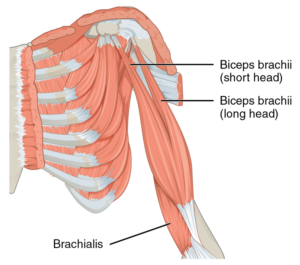Unleashing the Power of Biceps: A Comprehensive Guide
Biceps, the iconic symbol of strength and fitness, are a focal point for many fitness enthusiasts. Located in the front of the upper arm, the biceps brachii muscle plays a crucial role in various everyday activities and exercises. Understanding how to train and develop these muscles effectively can significantly enhance your overall strength and aesthetic appeal.
Anatomy of Biceps: The biceps brachii muscle is composed of two heads: the long head and the short head. The long head runs along the outside of the upper arm, while the short head is situated on the inside. These heads converge to form the biceps tendon, which attaches to the radius bone in the forearm. When the biceps contract, they flex the elbow joint and supinate the forearm (rotate it outward).

Benefits of Strong Biceps: Strong biceps offer numerous benefits beyond just aesthetic appeal. They contribute to improved arm strength, which is essential for lifting objects, performing daily tasks, and engaging in sports activities. Additionally, well-developed biceps can enhance overall upper body stability and assist in maintaining proper posture.
Effective Training Strategies: To maximize biceps growth and strength, incorporating a variety of exercises is key. Some of the most effective exercises include:
- Barbell Curl: This classic exercise targets both heads of the biceps and allows for progressive overload by increasing weight over time.
- Dumbbell Curl: By using dumbbells, you can work each arm independently, correcting any strength imbalances.
- Preacher Curl: This exercise isolates the biceps and reduces cheating or swinging motions, leading to better muscle activation.
- Hammer Curl: Targets the brachialis muscle, located underneath the biceps, contributing to overall arm thickness.
- Progressive Overload: One of the fundamental principles of biceps training is progressive overload. This means gradually increasing the resistance or intensity of your workouts to continually challenge your muscles and stimulate growth. Whether you’re using heavier weights, increasing repetitions, or altering your training volume, progressive overload keeps your biceps adapting and getting stronger over time.
- Mind-Muscle Connection: Developing a strong mind-muscle connection is crucial for optimizing biceps engagement during workouts. Focus on contracting the biceps throughout each repetition, emphasizing the squeeze at the top of the movement. This deliberate approach enhances muscle activation and promotes better results from your workouts.
- Recovery and Rest: Muscles grow and repair during periods of rest, making adequate recovery essential for biceps development. Ensure you’re getting enough sleep each night to support overall muscle recovery. Additionally, consider incorporating active recovery techniques such as foam rolling, stretching, and massage to alleviate muscle soreness and enhance recovery between workouts.
Nutrition and Recovery: Proper nutrition and recovery are vital for optimal biceps development. Ensure an adequate intake of protein to support muscle repair and growth. Additionally, prioritize rest and recovery days to allow muscles to heal and strengthen.
In conclusion, understanding the anatomy of biceps, incorporating effective training strategies, and focusing on nutrition and recovery are crucial steps towards achieving strong, well-defined biceps. By implementing these practices consistently, you can unlock the full potential of your arm strength and aesthetics.